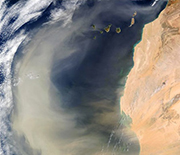News Release 18-018
New study finds world’s largest desert, the Sahara, has grown by 10 percent since 1920
Research is the first to assess century-scale changes to the Sahara's boundaries

Africa's Sahara Desert is expanding, encroaching on savanna ecosystems.
March 29, 2018
This material is available primarily for archival purposes. Telephone numbers or other contact information may be out of date; please see current contact information at media contacts.
The Sahara Desert has expanded by about 10 percent since 1920, according to a new study by National Science Foundation (NSF)-funded scientists at the University of Maryland (UMD).
The research is the first to assess century-scale changes to the boundaries of the world's largest desert. It suggests that other deserts could be expanding as well. The study is published today in the Journal of Climate.
"The trends in Africa of hot summers getting hotter and rainy seasons drying out are linked with factors that include increasing greenhouse gases and aerosols in the atmosphere," says Ming Cai, a program director in NSF's Division of Atmospheric and Geospace Sciences, which funded the research. "These trends have a devastating effect on the lives of African people, who depend on agriculture-based economies."
Deserts defined
Deserts are defined by low average annual rainfall -- usually 100 millimeters (less than 4 inches) of rain per year or less. The researchers analyzed annual rainfall data recorded throughout Africa from 1920 to 2013 and found that the Sahara, which occupies much of the northern part of the continent, expanded by 10 percent during this period.
When the scientists looked at seasonal trends over the same period, the most notable expansion of the Sahara occurred in summer, resulting in a nearly 16 percent increase in the desert's average area over the 93-year span covered by the study.
"Our results are specific to the Sahara, but they likely have implications for the world's other deserts," said Sumant Nigam, an atmospheric and ocean scientist at UMD, and the senior author of the study.
Why the expansion?
The results suggest that human-caused climate change, as well as natural climate cycles, caused the desert's expansion. The geographic pattern of expansion varied from season to season, with the largest differences along the Sahara's northern and southern boundaries.
"Deserts usually form in the subtropics because of what's called Hadley circulation, through which air rises at the equator and descends in the subtropics," Nigam said. That circulation has a drying effect. "Climate change is likely to widen this Hadley circulation, causing the northward advance of subtropical deserts," said Nigam. "The southward creep of the Sahara suggests that additional mechanisms are at work."
The Sahara is the world's largest warm-weather desert, roughly equal in size to the contiguous United States.
Like all deserts, the boundaries of the Sahara fluctuate with the seasons, expanding in the dry winter and contracting during the wetter summer.
The southern border of the Sahara adjoins the Sahel, the semi-arid transition zone that lies between the Sahara and fertile savannas farther south.
The Sahara expands as the Sahel retreats, disrupting the region's fragile savanna ecosystems and human societies. Lake Chad, which sits at the center of this transition zone, serves as a bellwether for changing conditions in the Sahel.
"The entire Chad Basin falls in the region where the Sahara has crept southward, and the lake is drying out," Nigam explained. "It's a very visible footprint of reduced rainfall not just locally, but across the whole region. It's an indicator of declining water in the Chad Basin."
Natural climate cycles, or climate change?
Natural climate cycles can affect rainfall in the Sahara and the Sahel. The researchers concluded that these climate cycles accounted for about two-thirds of the total expansion of the Sahara.
The remaining one-third can be attributed to human-caused climate change, but the authors note that longer climate records that extend across several climate cycles are needed to reach definitive conclusions.
"Many previous studies have documented trends in rainfall in the Sahara and Sahel, but our study is unique in that we use these trends to infer changes in the desert expanse on a century timescale," said researcher Natalie Thomas of UMD, lead author of the paper.
The results have far-reaching implications for the future of the Sahara and other subtropical deserts. As the world's population continues to grow, a reduction in land with adequate rainfall to support crops could have devastating consequences.
"Our priority was to document long-term trends in rainfall and temperature in the Sahara," said Thomas. "Our next step will be to look at what's driving these trends, for the Sahara and elsewhere.
"We've already started looking at seasonal temperature trends over North America, for example. Here, winters are getting warmer but summers are about the same. In Africa, it's the opposite -- winters are holding steady but summers are getting warmer. So the stresses in Africa are already more severe."
-NSF-
-
Satellite image showing the Sahara Desert (beige) and savannas to the south (green).
Credit and Larger Version -
A seemingly endless sea of sand, the Sahara stretches to the horizon.
Credit and Larger Version -
South of the Sahara is the Sahel transition zone between desert and savanna.
Credit and Larger Version -
An intense Saharan dust storm sends a massive dust plume northwestward over the Atlantic Ocean.
Credit and Larger Version
Media Contacts
Cheryl Dybas, NSF, (703) 292-7734, email: cdybas@nsf.gov
Matt Wright, University of Maryland, (301) 405-9267, email: mewright@umd.edu
The U.S. National Science Foundation propels the nation forward by advancing fundamental research in all fields of science and engineering. NSF supports research and people by providing facilities, instruments and funding to support their ingenuity and sustain the U.S. as a global leader in research and innovation. With a fiscal year 2023 budget of $9.5 billion, NSF funds reach all 50 states through grants to nearly 2,000 colleges, universities and institutions. Each year, NSF receives more than 40,000 competitive proposals and makes about 11,000 new awards. Those awards include support for cooperative research with industry, Arctic and Antarctic research and operations, and U.S. participation in international scientific efforts.
Connect with us online
NSF website: nsf.gov
NSF News: nsf.gov/news
For News Media: nsf.gov/news/newsroom
Statistics: nsf.gov/statistics/
Awards database: nsf.gov/awardsearch/
Follow us on social
Twitter: twitter.com/NSF
Facebook: facebook.com/US.NSF
Instagram: instagram.com/nsfgov






